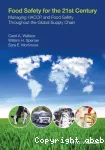Adresse
Infodoc : Réseau des bibliothèques et centres de documentation d'AgroParisTechFrance
contact

Détail de l'auteur
Auteur Sara E. Mortimore
Commentaire :
Directeur assurance qualité du groupe alimentaire britannique Grand métropolitain (en 1996)
|
Documents disponibles écrits par cet auteur (1)
 Ajouter le résultat dans votre panier Faire une suggestion Affiner la recherche Interroger des sources externes
Ajouter le résultat dans votre panier Faire une suggestion Affiner la recherche Interroger des sources externes
 Livre
LivreFood safety for the 21st century : managing HACCP and food safety throughout the global supply chain
978-1-118-89798-01 vol. (XXIII-328 p.)
1 vol. (XXIII-328 p.)ISBN : 978-1-118-89798-0




